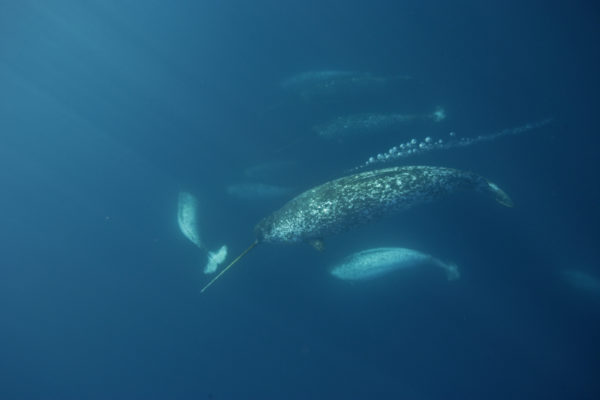Narwhals on the move
There was once a time when people believed that narwhals were the fabled unicorns, and their spiral tusks possessed magical properties. We now know that their tusks are actually a modified tooth with millions of nerve endings, but narwhal still remain one of the world’s most mysterious and elusive whales.
Narwhal spend their entire lives in extreme Arctic conditions. Their habitat has led them to evolve without a dorsal fin, allowing them to move easily beneath the frozen sea and seek out cracks in the ice to breathe. Using sound to both communicate and find food, they mainly inhabit the icy waters of Baffin Bay between Nunavut and west Greenland. Arctic marine mammal experts believe that narwhal are the ice whale most sensitive to the effects of climate change.
As the Arctic environment undergoes dramatic changes, narwhal will be confronted with unpredictable migratory routes and new predators such as the orca whales that are heading farther north. Melting sea ice has also opened the Arctic up to new possibilities for shipping and development – and the noise generated by these activities can interfere with narwhals’ ability to communicate and navigate, which could increase the likelihood of fatal ice entrapments.
Narwhal are a uniquely Canadian responsibility, as more than 90 per cent of the world’s narwhal spend their summer months in Canadian waters.
This is why Brandon Laforest, WWF-Canada’s senior specialist for Arctic species, travelled to Tremblay Sound in Nunavut’s Qikiqtaaluk Region in September, along with other researchers, to put tracking transmitter tags on these “unicorns of the sea.” Owing to their remote Arctic location and harshness of their habitat, narwhal are incredibly difficult to study. During two weeks of patiently waiting at an isolated camp, they were lucky enough to tag four narwhal travelling towards Baffin Bay for the winter. The information gathered will help us learn more about this spiked whale’s habitat and find solutions to help narwhal thrive in a changing world, including ensuring the waters where they swim are carefully managed.
Check out our tracking map to see the incredible journey narwhal and other Arctic species are on:
You can help by adopting a species
If tracking species online isn’t exciting enough, you can bring one home for the holidays. Your symbolic adoption will help support conservation initiatives like this narwhal tagging expedition and other projects that help us identify and protect critical wildlife habitats.
Each adoption kit includes an adorable cuddly toy, personalized adoption certificate, a stunning educational species poster, a reusable tote bag and a charitable tax receipt.



